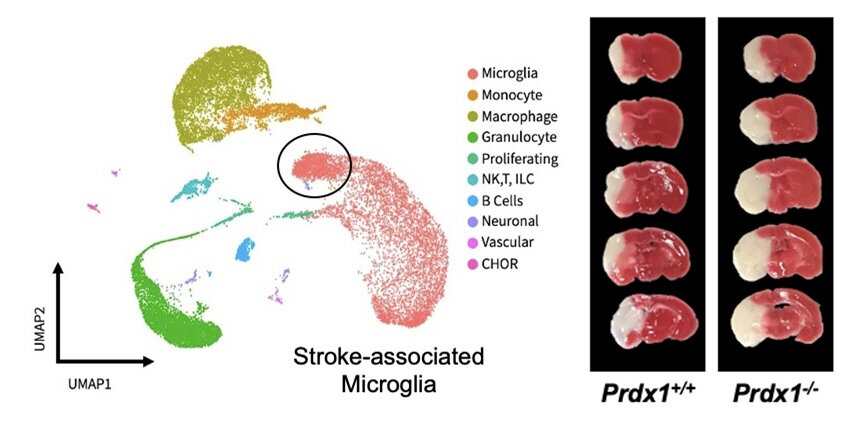
A new study identifies a unique type of microglia associated with stroke in the I/R-injured brain
Peroxiredoxin1 (Prdx1) is required for SAM activation after stroke injury. (Left) UMAP plots showing clusters and annotations of cells detected in Prdx1+/+ and Prdx1−/− IL hemispheres after tMCAO. (Right) Representative images of TTC-stained brain sections of Prdx1+/+ (n = 18) and Prdx1−/− (n = 22) mice. Author: UNIST
A UNIST-affiliated research team has identified a new type of stroke-associated microglia in the ischemia/reperfusion (I/R)-injured brain. This breakthrough was led by Prof. Sung Ho Park and his research team from UNIST’s Department of Biological Sciences in collaboration with a research team led by Prof. Goo Taeg Oh from Iwha Women’s University.
Microglia, the main immune cells in the central nervous system (CNS), are known to eliminate unwanted microbes and debris and remove dying neurons. In this study, the research team classified a new type of microglia with enhanced antioxidant function and markers similar to disease-associated microglia (DAM) and designated them as a stroke-associated microglia (SAM).
Via animal experimentsresearch team demonstrated that the presence of the typical antioxidant gene peroxiredoxin-1 (Prdx1) protects against acute I/R injury and is required for SAM activation and subsequent reduction of microglial cell death and inflammatory responses.
In addition, after performing transient middle cerebral artery occlusion (tMCAO) induction surgery ischemic stroke in mice, the research team found that Prdx1−/− mice were more severely injured by acute I/R injury as evidenced by TTC staining, neurological deficit scores, motor tests, and survival, indicating that Prdx1 has a protective function .
“In this study, we identified for the first time a specialized and characteristic type of microglia with enhanced antioxidant function in stroke mice,” says Professor Park. “Prdx1-dependent SAM may be a potential biomarker and therapeutic target for protecting microglial function and treating brain I/R injury,” he adds, “Although it new cluster will require further study, our findings provide a new perspective that Prdx1-mediated microglial heterogeneity is important in ischemic stroke.”
Wonhyo Lee, a postdoctoral fellow in the Department of Biological Sciences at UNIST, and Sinae Kim, a postdoctoral fellow in the Department of Life Sciences at Iwha Women’s University, jointly participated in this study as first authors. Their results were published in Redox biology.
Sinai Kim et al. The antioxidant enzyme peroxiredoxin-1 controls stroke-associated microglia against acute ischemic stroke, Redox biology (2022). DOI: 10.1016/j.redox.2022.102347
Citation: New study identifies unique type of stroke-associated microglia in I/R-injured brain (October 24, 2022) Retrieved October 24, 2022 from https://medicalxpress.com/news/2022-10-unique- microglia-ir-brain .html
This document is subject to copyright. Except in good faith for the purpose of private study or research, no part may be reproduced without written permission. The content is provided for informational purposes only.


